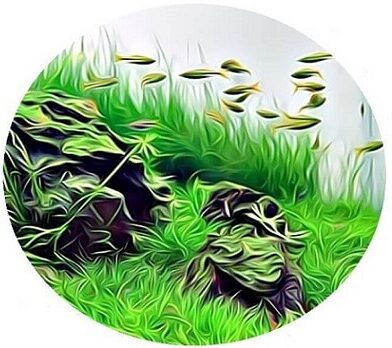Detritus worms vs Planaria
If you look at some Facebook Fish Group or Reddit Fish Keeper community, you will see many worms-related questions.
Most of the time, these worms are Detritus worms or a Planaria.
In this article, I will explain how to identify and eliminate them.
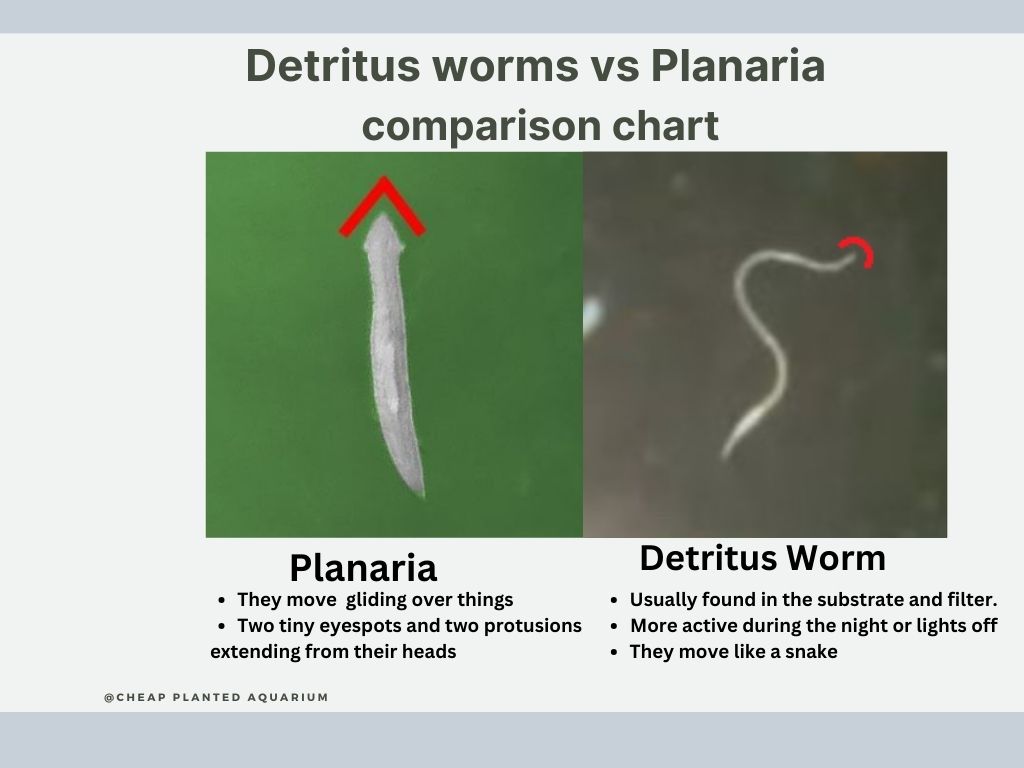
Detritus Worms
Detritus Worms are the most common worms found in fish tank environments.
They are typically small long white worms which wiggle about in the substrate. They are usually from the “annelid worms” class and have segments in their body.
Quoting the Aquarium Science article ““ “Detritus worms” are by definition simply ANY “WORM” which lives in the DETRITUS of an aquarium or an aquarium filter. These “worms” can come from many different animal phylums that are in no way related. There are thousands of species, colors and sizes”. ””.
This article focus on the most commonly found in fresh water tanks.
They are thin, stringy and whitish-grown.
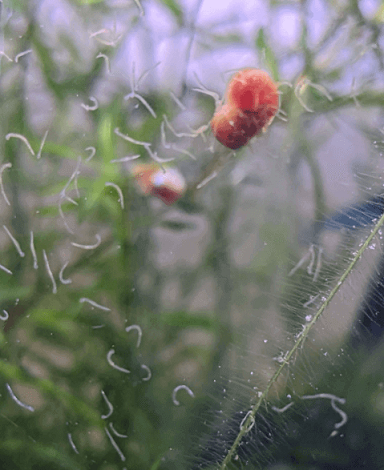
These worms eat fish waste, uneaten fish food, decomposed organic material, etc.
It’s not recommended the use of chemicals or medications to eliminate them, as this will not solve the real reason you have these worms in your tank.
How do you identify detritus worms?
To identify detritus worms, look at their body form (thin and white – very different from a Planaria as they don’t have that triangle head) and how they move (like a snake, quickly wriggling).
They are more active during the night or when the lights are off.
Are Detritus worms harmful?
Detritus Worms do not harm your fish but indicate something is wrong in your tank — usually, poor tank maintenance or overfeeding your fish, which, sooner or later, will become ammonia, which is very toxic and can kill fish.
Curiously, you will even find aquarists intentionally introducing them to their tank as they are a good snack for fish. Some people grow them to make money or have live food for their fish.
How to Grow Detritus Worms
All Credits to David Ramsey ! Follow this Amazing Youtuber.
Where do Detritus worms come from? How did detritus worms get in my tank?
Detritus worms come from substrates transferred from another tank or with plants you bought or collected from somewhere.
Detritus worms get in your tank hidden in soil & substrate that comes with plants you just bought or collected.
How do I reduce detritus worms in my aquarium? How do I get rid of them?
To reduce or get rid of detritus worms you need to:
- Give a deep and thorough cleaning to your tank’s gravel or substrate using a simple rose or some gravel vacuums.
- Repeat this process 4 or 5 times each 2 or 3 days (Monday, Wednesday, Friday, Sunday, Tuesday).
- Attention: As usual, take care of the water you are refilling your tank. Make sure pH, Ammonia, Nitrite, Nitrate and Chlorine are aligned with the water you have in your tank.
- Avoid replacing more than 70% of your tank’s water each time to avoid health issues.
- Attention: Keep attention to your fish, shrimp, and snails, as these frequent water changes can cause health issues if the water you use to refill your tank is very different from the water you have in your tank. Stop if something feels not right.
- Remove and Clean your filtration system.
- Reduce food quantity for some days; after that, ensure you are not overfeeding them (fish should eat in less than one minute all the food).
- Check your Ammonia, Nitrite and Nitrate levels to make sure your biological filter is working fine and or your aquarium is not overstocked (high ammonia or nitrite is a signal of overstocked tank).
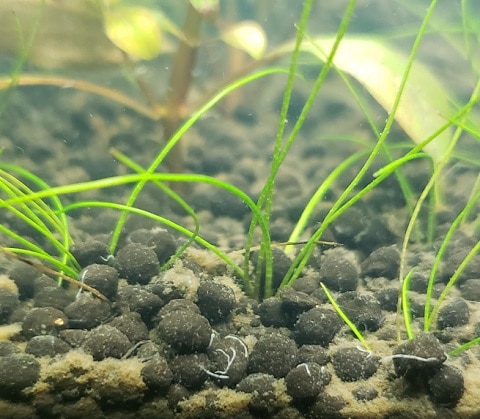
What fish eat Detritus worms?
Many fish eat Detritus worms, and this is actually the best way to get rid of them (instead of using chemicals, for example).
Some of these fish are:
- Bettas
- Plecos
- Zebra, Kuhli, Clown, Yoyo, Other Loach species
- Corydoras
- Angel fish
Will shrimp eat Detritus worms?
Shrimps don’t usually hunt and eat Detritus worms. If they are dead, shrimps will eat as they eat almost everything.
Do snails eat Detritus worms?
Snails don’t eat Detritus worms.
What are the Pros and Cons of having Detritus Worms in your tank
The Pros and Cons of having Detritus Worms in your tank are:
Are detritus worms good for aquarium?
Detritus worms are good for aquarium as they help you on your cleaning routine by eating leftovers, waste, etc. They are also a good protein source for your fish.
Cons of having detritus worms:
They don’t look nice and we all want our tank to look amazing.
Planaria
Planaria is a flatworm that leaves in both saltwater and freshwater ponds and rivers. They are not so common to be found and, well, not so easy to get rid of.
How do you identify a Planaria
To identify a Planaria, look closely at it and check its head format and how it moves.
They are very small, and when looking at them very closely, you can see two tiny eyespots and two protrusions extending from their heads.
They move differently, gliding over things. They don’t have a snake-like movement.
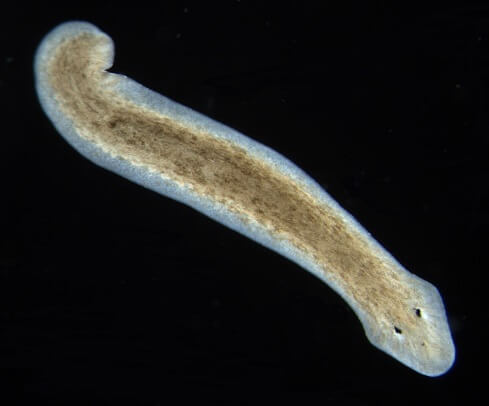
Planaria can be seen, sometimes, crawling the aquarium glass.
They are asexual and can reproduce without mating. Planaria are difficult to find and can cause severe problems even when you have a few.
They can, for example, eat mystery snails and shrimp. They have been found clambering over fish, sliding into gills or other parts, causing stress and health issues.
Are Planaria harmful
Planaria worms are harmful. They can and will eat mystery snails!
Where do Planaria worms come from? How did Planaria get in my tank?
Planaria worms come from new fish, shrimp, snails, or non-frozen fresh fish food.
That is why you must quarantine your new fish, shrimp, or snails before you put them into your main tank.
How to get rid of them
I will present you with three methods to get rid of Planaria. Independently of which one you choose, the most important thing to do is to stop feeding it. Reduce the quantity of food you offer to the amount your fish can eat in less than one minute. If your fish don’t eat all the food, remove it quickly and give less the next day.
How to get rid of Planaria using live fish:
Many fish species eat Planaria. Guppies, Gouramis, Goldfish, Angelfish, Mollies, and other fish are known to eat Planaria.
This is the best and safest method.
How to get rid of Planaria using a trap:
To get rid of Planaria using a trap is super easy, and it’s the second best and safest method. Using the live fish method is better and more manageable as they will keep looking for food all day long, so you will never need to replace the trap, clean it, etc., but a trap is still easy and efficient.
Due to its low price, a Planaria trap can be an additional way to handle these worms faster.
This is the Planaria trap I recommend
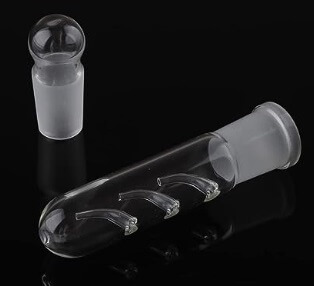
The Planaria can fit in there, but the snails can’t.
How to use a Planaria trap
Planaria traps are easy to set up and use. Each vendor could have particularities on their trap, like a rubber on the top, a small weight, etc. That said, follow the manufacturer’s instructions to set your trap accordingly.
This video will show you some tips and tricks and give you an idea of how easy it is to set up them.
How to get rid of Planaria using chemicals:
To get rid of Planaria worms using Chemicals, you must first know that you only should use this method as your last resource. Warfare! Battle Mode. Read and research before you use some medication.
There are many chemicals & medications that can be used to get rid of these pests.
They are very toxic to snails and will stay in your tank’s water for some time, so if you plan to use them and have snails, make sure you have a safe place to keep your snails for at least 30 days.
Make sure you read and follow the manufacturer’s instructions when using these products.
Always use the precise dosage. Remember that if your tank is 30 gallons but is 90% full of water, you have 27 gallons and not 30.
If you have invertebrates, you might need to remove them from the tank, but again, do read and follow the manufacturer’s instructions!
After some days of using these chemicals, discard and replace your biological media.
Wait 30 days after the last Planaria sighting to ensure you have eliminated them.
Before returning snails and shrimps to your tank, make sure you did 2 or 3 water changes to eliminate those chemicals.
Wait 30 days or more before putting them back in the tank. There are reports of people using these meds that added snails back two months after a bunch of water changes and carbon, and the snails still died.
Having that said, follow the instructions of the chemical you are using.
What to do after you get rid of the Planaria Worms?
After you get rid of the Planaria worms, work to avoid new infestations by taking these simple measures:
- Only buy plants from reputable fish stores.
- Avoid taking plants from pounds or natural environments.
- Reduce food quantity. Ensure you are not overfeeding. If your fish and inverts fail to eat all the food, remove it on time.
These simple steps should prevent a new Planaria infestation and help you battle the current one.
What fish eat Planaria Worm?
There are reports of Bettas, Boraras, Celestial Pearl Danios, Barbs and Plecos eating Planaria when left without food for some days.
References
North Caroline Museum of Natural Sciences, here and here.
If you are looking to start your Planted Aquarium journey, check this article, but if you decided to go with a Low Tech Planted Aquarium, this one will be helpful.
Detritus Worms from Aqua Science Organization here.
If you have questions or suggestions, reach out to me here.
